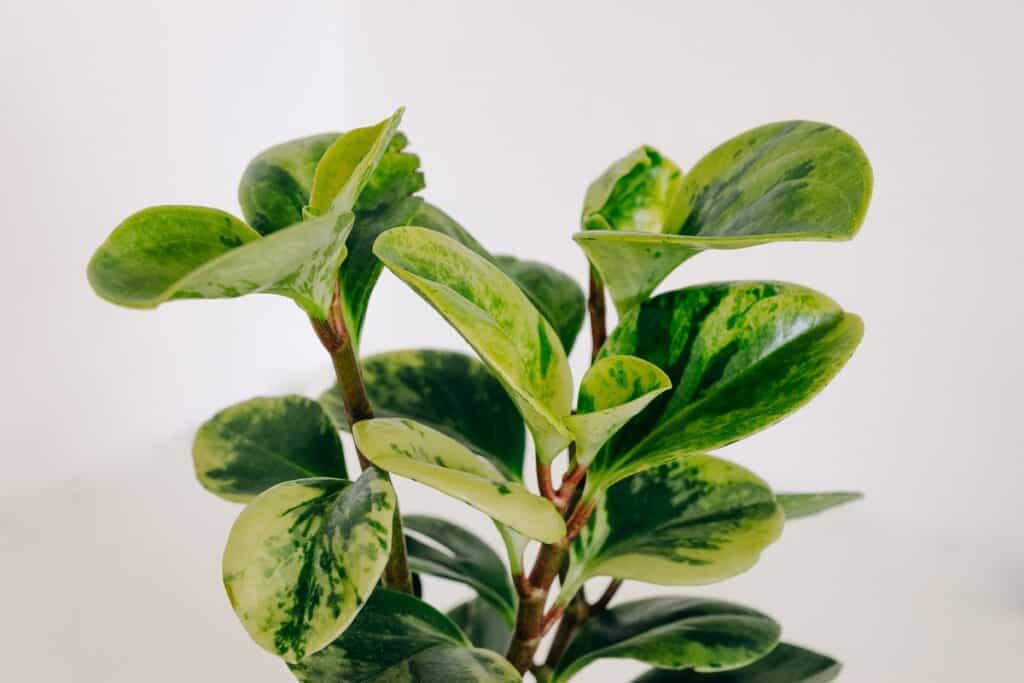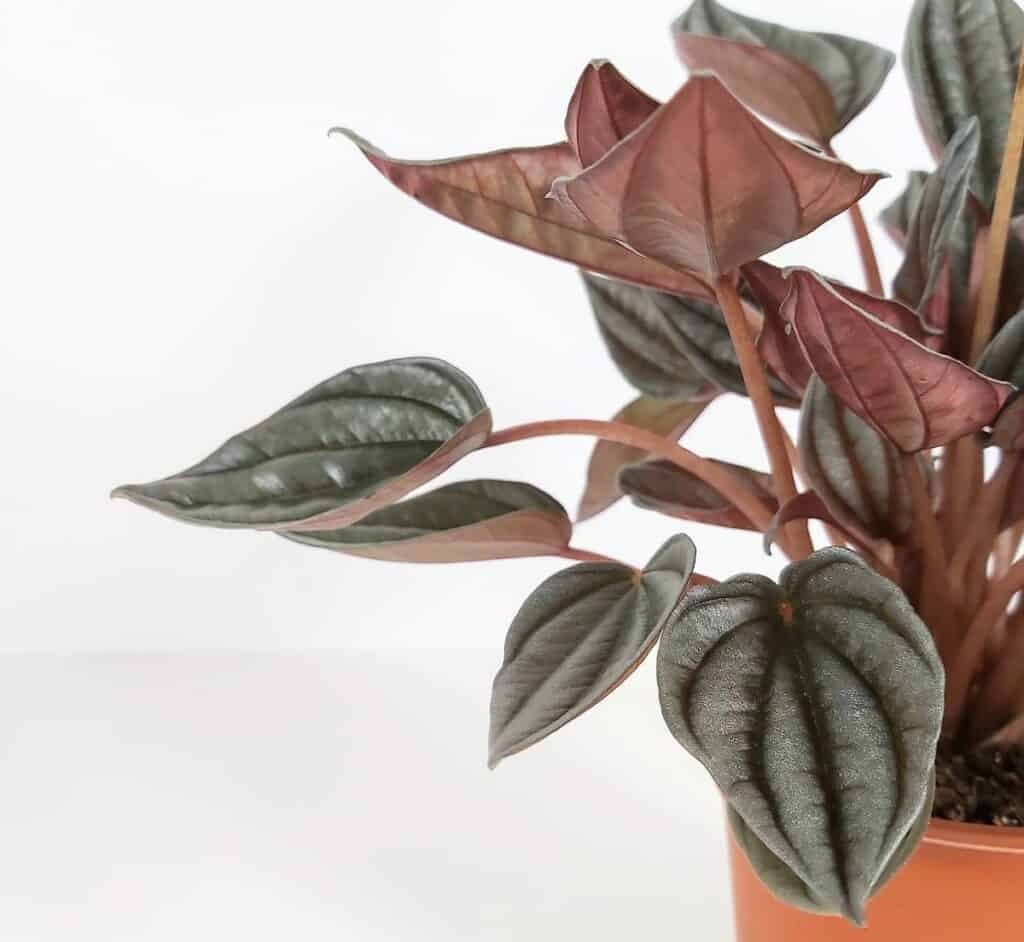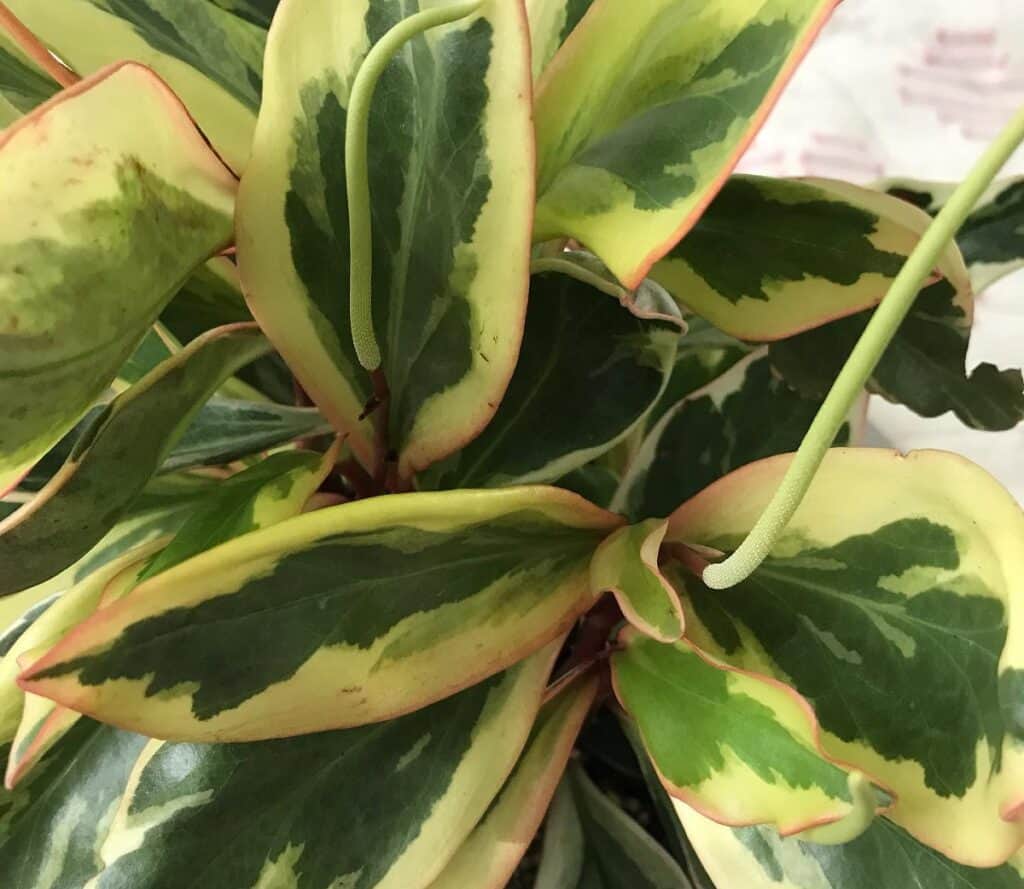As any experienced houseplant grower knows, there are several potential causes of Peperomia leaf curling. It could be due to temperature fluctuations, overly moist soil, too much fertilizer, or even a lack of humidity. But, how do you know which one it is? In this article, we’ll explore the most common causes of Peperomia leaves curling and the best solutions to get your plant healthy again.

Contents
- 1 Causes Of Peperomia Leaves Curling
- 2 Frequently Asked Questions
- 2.1 What are the most common causes of Peperomia leaves curling?
- 2.2 How do you uncurl Peperomia leaves?
- 2.3 Is my Peperomia overwatered or underwatered?
- 2.4 How do you fix droopy Peperomia?
- 2.5 Do Peperomia like moist soil?
- 2.6 How do you know if Peperomia has root rot?
- 2.7 What kind of soil does Peperomia need?
- 2.8 When should I repot my Peperomia?
- 3 Conclusion
Causes Of Peperomia Leaves Curling
Peperomia leaves are known for their bright colors and interesting shapes. Unfortunately, these leaves can start to curl and become unsightly if they are not given the proper care. There are several possible causes of peperomia leaves curling, including environmental factors, pests, and diseases.
1. Improper Lighting
Peperomia plants prefer moderate to bright indirect light. If the plant is exposed to too much direct sunlight, the leaves can curl and turn yellow.
Solution: Move the plant to an area with indirect sunlight.
2. Water Stress
Too much or too little water can cause damage to the plant’s leaves, including leaf curling. Too much water can cause root rot, leading to curled and wilted leaves.
Solution: Check the soil moisture levels often and water when the top inch of soil is dry.
3. Low Humidity
Peperomia plants require high humidity levels to thrive. If the humidity is too low, the leaves will begin to curl.
Solution: Increase humidity in the environment by misting the plant regularly or placing it near a humidifier.
4. Temperature Stress
Peperomia plants cannot tolerate temperatures below 55℉.
Solution: Move the plant to an area where the temperature is consistently above 55℉.
5. Nutrient Deficiency
Peperomia plants require plenty of nutrients. If the plant is not receiving enough, the leaves may begin to curl.
Solution: Feed the plant a balanced fertilizer every two weeks during the growing season.
6. Pests
Insects like aphids and mealybugs can cause damage to the plant’s leaves.
Solution: Inspect the plant regularly for signs of pests and treat with an appropriate insecticide.
7. Too Much Fertilizer
Too much fertilizer can burn the roots, leading to wilted and curled leaves.
Solution: Use a balanced fertilizer and only apply when needed.
8. Repotting Stress
Repotting can cause stress to the plant, leading to curled leaves.
Solution: Repot the plant slowly and carefully to reduce stress.
Frequently Asked Questions

What are the most common causes of Peperomia leaves curling?
The most common causes of Peperomia leaves curling are related to environmental conditions. These issues can be addressed by adjusting the plant’s environment and providing proper care.
When too little water is the cause, the leaves will start to curl and wilt due to the plant not being able to absorb enough water to keep its leaves healthy and hydrated. Too much water can also cause Peperomia leaves to curl. When the soil is constantly saturated with water, the roots of the plant cannot absorb the oxygen they need to survive. This leads to the leaves curling up and turning yellow due to the plant not being able to take in enough oxygen.
Temperature can also play a role in Peperomia leaves curling. If the temperature is too cold, the leaves will curl up and turn yellow due to the plant not being able to tolerate the cold. Similarly, if the temperature is too hot, the leaves will curl up and turn brown due to the plant not being able to tolerate the heat.
Inappropriate light levels can also lead to Peperomia leaves curling. If the plant is exposed to too much direct sunlight, the leaves will curl and become scorched. On the other hand, if the plant is not exposed to enough light, it will not be able to produce enough energy to keep its leaves healthy and hydrated, leading to them curling up.
Humidity can also play a role in Peperomia leaves curling. If the humidity level is too low, the leaves will start to curl up due to the plant’s inability to absorb enough water through its leaves.
How do you uncurl Peperomia leaves?
Fixing Peperomia leaves that are curling requires a careful assessment of the underlying causes. If environmental stress is the cause of the curling leaves, the solution is to increase humidity and provide more shade. You should also check the temperature and make sure the plant is not exposed to temperatures that are too high or too low. Additionally, make sure the soil is moist but not waterlogged.
If nutritional deficiencies are causing the curling leaves, then a balanced fertilizer should be applied to the soil. Make sure to use a fertilizer specifically formulated for Peperomia plants and follow the instructions carefully.
Finally, if pests cause the curling leaves, then the best way to fix them is to remove them. This can be done with a combination of mechanical removal, such as picking off the pests, and chemical control, such as spraying the plant with an appropriate pesticide. Make sure to follow the instructions carefully when using any chemical control.
Once the underlying cause of the curling leaves has been identified and addressed, the Peperomia leaves should begin to uncurl. However, it is important to monitor the plant closely and take any further action as needed.

Is my Peperomia overwatered or underwatered?
It can be difficult to tell if a Peperomia is overwatered or underwatered without further investigation. Signs of overwatering include yellowing or browning leaves, soft stems, and root rot. Signs of underwatering include wilting, dry soil, and curled or crispy leaves
To ensure the health of your Peperomia, it is important to check the soil regularly and make sure it is moist but not soggy. Additionally, it is important to make sure the plant is getting enough sunlight, as too little light can cause the plant to become stressed and start to show signs of underwatering. With the right care and attention, your Peperomia can be healthy and happy.
How do you fix droopy Peperomia?
The best way to fix a droopy Peperomia is to identify and address the underlying cause. Underwatering is the most common cause of droopiness, so the first step should be to check the soil and make sure it is not too dry. If it is, then the plant should be watered thoroughly. If the soil is already moist, then the problem may lie with the plant’s roots. This could be due to root rot, caused by overwatering or poor drainage, or it could be due to compaction of the soil.
In either case, carefully remove the plant from its pot and examine the roots. If they are brown or mushy, then they should be pruned off. If the roots are healthy, but the soil is compacted, repot the plant in fresh, loose soil. Finally, make sure the plant is getting enough light; a Peperomia prefers bright, indirect light.
Do Peperomia like moist soil?
Peperomia plants prefer moist soil, but not soggy soil. Over-watering these plants can lead to root rot. It is generally best to water Peperomia plants when the top inch of soil is dry. If you are unsure, it is best to check the soil moisture before watering. If the soil is too dry, add water until it is evenly moist. But if the soil is too wet, wait a few days before watering again.
Peperomia plants like well-drained soil, so it is important to use a potting mix that is well-aerated and drains quickly. You can also add some perlite or pumice to help the soil drain better. When you water your Peperomia, make sure to use room-temperature water. This will help the roots absorb the water more easily.
How do you know if Peperomia has root rot?
One of the most obvious signs of root rot in Peperomia is the presence of soft, brown, or black, slimy roots. If the plant is not actively growing and you notice these signs, then it is likely root rot. Additionally, the leaves of the plant may begin to yellow, wilt, and drop off, indicating that the plant is struggling to take up water and nutrients due to the presence of rot.
If you notice any of these symptoms, it is important to act quickly and remove the affected roots, prune any affected foliage, and repot the plant in fresh, sterile soil with good drainage. To prevent root rot, it is important to water the plant only when the soil is dry, to avoid over-watering and standing water, and to provide good air circulation.
What kind of soil does Peperomia need?
Peperomia plants prefer well-draining, nutrient-rich soil. A peat-based soil mix with a pH of 6.0 to 6.5 is ideal. You can also add a few inches of coarse sand or perlite to the soil mix to help improve drainage. Additionally, a good quality potting mix with compost or organic matter can help provide extra nutrients.
Be sure to avoid using soils that contain too much clay, as this can lead to waterlogging, which can be harmful to the plant. Additionally, you should be sure to fertilize your Peperomia plants every few weeks to ensure they get all the nutrients they need.
When should I repot my Peperomia?
Peperomia plants should generally be repotted every 1 to 2 years. The best time to repot your Peperomia is in the early spring when the plant is coming out of its winter dormancy and beginning to actively grow again. This is when the plant will benefit most from the nutrients and fresh soil that a new pot can offer.
Before repotting, make sure to check the roots of your Peperomia to see if they are overcrowded or if they have outgrown the current pot. If the roots are winding around the sides of the pot, it’s time to repot. When repotting, use a well-draining potting mix and make sure that the pot is not too large for the plant. Peperomia plants prefer to be slightly root bound, so it is better to err on the side of caution and choose a pot that is only slightly larger than the current one.
Conclusion
In conclusion, Peperomia leaves curling is a common issue that can be caused by a variety of environmental conditions, including over or under-watering, low humidity, and temperature fluctuations. Fortunately, it is usually easy to fix with a few simple solutions. By addressing environmental conditions, it is possible to stop Peperomia leaves from curling. Proper care and attention can help to ensure that Peperomia plants remain healthy and happy.
